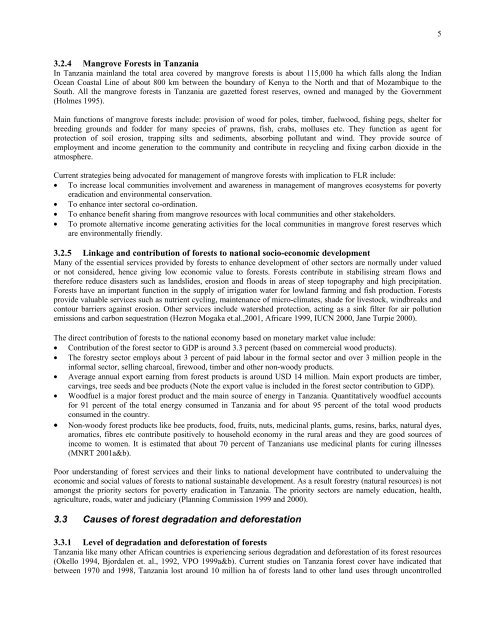FOREST LANDSCAPE RESTORATION - UNEP World Conservation ...
FOREST LANDSCAPE RESTORATION - UNEP World Conservation ...
FOREST LANDSCAPE RESTORATION - UNEP World Conservation ...
You also want an ePaper? Increase the reach of your titles
YUMPU automatically turns print PDFs into web optimized ePapers that Google loves.
5<br />
3.2.4 Mangrove Forests in Tanzania<br />
In Tanzania mainland the total area covered by mangrove forests is about 115,000 ha which falls along the Indian<br />
Ocean Coastal Line of about 800 km between the boundary of Kenya to the North and that of Mozambique to the<br />
South. All the mangrove forests in Tanzania are gazetted forest reserves, owned and managed by the Government<br />
(Holmes 1995).<br />
Main functions of mangrove forests include: provision of wood for poles, timber, fuelwood, fishing pegs, shelter for<br />
breeding grounds and fodder for many species of prawns, fish, crabs, molluses etc. They function as agent for<br />
protection of soil erosion, trapping silts and sediments, absorbing pollutant and wind. They provide source of<br />
employment and income generation to the community and contribute in recycling and fixing carbon dioxide in the<br />
atmosphere.<br />
Current strategies being advocated for management of mangrove forests with implication to FLR include:<br />
• To increase local communities involvement and awareness in management of mangroves ecosystems for poverty<br />
eradication and environmental conservation.<br />
• To enhance inter sectoral co-ordination.<br />
• To enhance benefit sharing from mangrove resources with local communities and other stakeholders.<br />
• To promote alternative income generating activities for the local communities in mangrove forest reserves which<br />
are environmentally friendly.<br />
3.2.5 Linkage and contribution of forests to national socio-economic development<br />
Many of the essential services provided by forests to enhance development of other sectors are normally under valued<br />
or not considered, hence giving low economic value to forests. Forests contribute in stabilising stream flows and<br />
therefore reduce disasters such as landslides, erosion and floods in areas of steep topography and high precipitation.<br />
Forests have an important function in the supply of irrigation water for lowland farming and fish production. Forests<br />
provide valuable services such as nutrient cycling, maintenance of micro-climates, shade for livestock, windbreaks and<br />
contour barriers against erosion. Other services include watershed protection, acting as a sink filter for air pollution<br />
emissions and carbon sequestration (Hezron Mogaka et.al.,2001, Africare 1999, IUCN 2000, Jane Turpie 2000).<br />
The direct contribution of forests to the national economy based on monetary market value include:<br />
• Contribution of the forest sector to GDP is around 3.3 percent (based on commercial wood products).<br />
• The forestry sector employs about 3 percent of paid labour in the formal sector and over 3 million people in the<br />
informal sector, selling charcoal, firewood, timber and other non-woody products.<br />
• Average annual export earning from forest products is around USD 14 million. Main export products are timber,<br />
carvings, tree seeds and bee products (Note the export value is included in the forest sector contribution to GDP).<br />
• Woodfuel is a major forest product and the main source of energy in Tanzania. Quantitatively woodfuel accounts<br />
for 91 percent of the total energy consumed in Tanzania and for about 95 percent of the total wood products<br />
consumed in the country.<br />
• Non-woody forest products like bee products, food, fruits, nuts, medicinal plants, gums, resins, barks, natural dyes,<br />
aromatics, fibres etc contribute positively to household economy in the rural areas and they are good sources of<br />
income to women. It is estimated that about 70 percent of Tanzanians use medicinal plants for curing illnesses<br />
(MNRT 2001a&b).<br />
Poor understanding of forest services and their links to national development have contributed to undervaluing the<br />
economic and social values of forests to national sustainable development. As a result forestry (natural resources) is not<br />
amongst the priority sectors for poverty eradication in Tanzania. The priority sectors are namely education, health,<br />
agriculture, roads, water and judiciary (Planning Commission 1999 and 2000).<br />
3.3 Causes of forest degradation and deforestation<br />
3.3.1 Level of degradation and deforestation of forests<br />
Tanzania like many other African countries is experiencing serious degradation and deforestation of its forest resources<br />
(Okello 1994, Bjordalen et. al., 1992, VPO 1999a&b). Current studies on Tanzania forest cover have indicated that<br />
between 1970 and 1998, Tanzania lost around 10 million ha of forests land to other land uses through uncontrolled
















